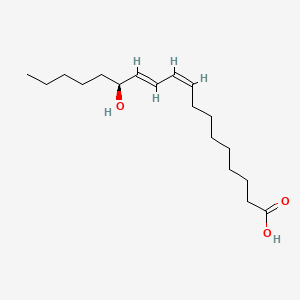| MeSH term | MeSH ID | Detail |
|---|---|---|
| Adenomatous Polyps | D018256 | 4 associated lipids |
| Zellweger Syndrome | D015211 | 39 associated lipids |
| Colorectal Neoplasms | D015179 | 10 associated lipids |
| Thrombosis | D013927 | 49 associated lipids |
| Adenomatous Polyposis Coli | D011125 | 16 associated lipids |
| Familial Mediterranean Fever | D010505 | 12 associated lipids |
| Hypertension | D006973 | 115 associated lipids |
| Colonic Neoplasms | D003110 | 161 associated lipids |
| Cell Transformation, Neoplastic | D002471 | 126 associated lipids |
| Arteriosclerosis | D001161 | 86 associated lipids |
| Adenocarcinoma | D000230 | 166 associated lipids |
29623-28-7
29623-28-7 is a lipid of Fatty Acyls (FA) class.
Cross Reference
There are no associated biomedical information in the current reference collection.
Current reference collection contains 1002 references associated with 29623-28-7 in LipidPedia. Due to lack of full text of references or no associated biomedical terms are recognized in our current text-mining method, we cannot extract any biomedical terms related to diseases, pathways, locations, functions, genes, lipids, and animal models from the associated reference collection.
Users can download the reference list at the bottom of this page and read the reference manually to find out biomedical information.
Here are additional resources we collected from PubChem and MeSH for 29623-28-7
Possible diseases from mapped MeSH terms on references
We collected disease MeSH terms mapped to the references associated with 29623-28-7
PubChem Associated disorders and diseases
PubChem Biomolecular Interactions and Pathways
NCBI Entrez Crosslinks
All references with 29623-28-7
Download all related citations| Authors | Title | Published | Journal | PubMed Link |
|---|---|---|---|---|
| Buchanan MR et al. | 13-Hydroxyoctadecadienoic acid is the vessel wall chemorepellant factor, LOX. | 1985 | J. Biol. Chem. | pmid:3934168 |
| Ek-Von Mentzer BA et al. | Binding of 13-HODE and 15-HETE to phospholipid bilayers, albumin, and intracellular fatty acid binding proteins. implications for transmembrane and intracellular transport and for protection from lipid peroxidation. | 2001 | J. Biol. Chem. | pmid:11278949 |
| Hsi LC et al. | 15-lipoxygenase-1 metabolites down-regulate peroxisome proliferator-activated receptor gamma via the MAPK signaling pathway. | 2001 | J. Biol. Chem. | pmid:11447213 |
| Hatley ME et al. | Increased production of 12/15 lipoxygenase eicosanoids accelerates monocyte/endothelial interactions in diabetic db/db mice. | 2003 | J. Biol. Chem. | pmid:12734208 |
| Cimen I et al. | 15-lipoxygenase-1 exerts its tumor suppressive role by inhibiting nuclear factor-kappa B via activation of PPAR gamma. | 2011 | J. Cell. Biochem. | pmid:21544861 |
| Dandona P et al. | The suppressive effect of dietary restriction and weight loss in the obese on the generation of reactive oxygen species by leukocytes, lipid peroxidation, and protein carbonylation. | 2001 | J. Clin. Endocrinol. Metab. | pmid:11232024 |
| Aljada A et al. | Nuclear factor-kappaB suppressive and inhibitor-kappaB stimulatory effects of troglitazone in obese patients with type 2 diabetes: evidence of an antiinflammatory action? | 2001 | J. Clin. Endocrinol. Metab. | pmid:11443197 |
| Schild RL et al. | The activity of PPAR gamma in primary human trophoblasts is enhanced by oxidized lipids. | 2002 | J. Clin. Endocrinol. Metab. | pmid:11889173 |
| Aljada A et al. | Troglitazone reduces the expression of PPARgamma while stimulating that of PPARalpha in mononuclear cells in obese subjects. | 2001 | J. Clin. Endocrinol. Metab. | pmid:11443177 |
| Han KH et al. | Oxidized LDL reduces monocyte CCR2 expression through pathways involving peroxisome proliferator-activated receptor gamma. | 2000 | J. Clin. Invest. | pmid:10995790 |
